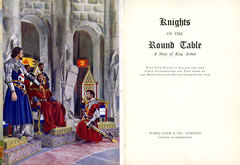Knights of the Round Table
You may click on the thumbnail images to view them full screen

Knights of the Round Table (MGM, 1953; dir. Richard Thorpe).
Knights of the Round Table: A Story of King Arthur. With Four Plates in Colour and over Forty Illustrations and Text Based on the Metro-Goldwyn-Mayer CinemaScope Film. London: Ward, Lock & Co., 1954.
Knights of the Round Table. Dell Comic No. 540. Based on the MGM Motion Picture. 1954.
Knights of the Round Table claims to be 'based on Sir Thomas Malory's Le Morte D'Arthur.' This claim, echoed in other films and literary works, is much like Malory's claim of a French book as a source, even for parts of his story that he seems to have created himself: that is, it is a way of lending authority to the story since, for the English-speaking world, Malory's version of the Arthurian legend is the source of so much that comes after him.
 Indeed many of the traditional characters are featured in the film, though often in some untraditional situations. Morgan le Fay (Anne Crawford), for example, supports Modred (Stanley Baker), whom she wants to install as king and with whom she plots to destroy her half-brother. Here, Arthur (Mel Ferrer) is an adult, not a boy, when he first pulls the sword from the stone; and, after fighting for many months to prove with deeds rather than words his right to rule, he draws Excalibur from the stone again, this time at 'the ring of stones,' before the council of lords. In this film, Elaine (Maureen Swanson) is not only the sister of Percival (Gabriel Woolf) but also the wife of Lancelot (Robert Taylor), who married her, at the suggestion of Guinevere (Ava Gardner), to quell the gossip at court. Together, Lancelot and Elaine move to the north country, where he grows genuinely fond of her, and they live happily for a time, until she dies giving birth to their son Galahad. After Elaine's death, Lancelot returns to Camelot, where Modred exploits and exposes his rather chaste affection for Guinevere; and, although Arthur banishes him, Lancelot returns again for a reconciliation with his dying king and friend—and even, at Arthur's request, to cast Excalibur into the sea. The film ends with Percival and Lancelot at the now-empty hall of the Round Table, where the former sees the Grail and the latter is told in voice-over to take comfort because 'nothing is lost'; Lancelot's own sins have been forgiven, and his son Galahad will be the greatest knight of all.
Indeed many of the traditional characters are featured in the film, though often in some untraditional situations. Morgan le Fay (Anne Crawford), for example, supports Modred (Stanley Baker), whom she wants to install as king and with whom she plots to destroy her half-brother. Here, Arthur (Mel Ferrer) is an adult, not a boy, when he first pulls the sword from the stone; and, after fighting for many months to prove with deeds rather than words his right to rule, he draws Excalibur from the stone again, this time at 'the ring of stones,' before the council of lords. In this film, Elaine (Maureen Swanson) is not only the sister of Percival (Gabriel Woolf) but also the wife of Lancelot (Robert Taylor), who married her, at the suggestion of Guinevere (Ava Gardner), to quell the gossip at court. Together, Lancelot and Elaine move to the north country, where he grows genuinely fond of her, and they live happily for a time, until she dies giving birth to their son Galahad. After Elaine's death, Lancelot returns to Camelot, where Modred exploits and exposes his rather chaste affection for Guinevere; and, although Arthur banishes him, Lancelot returns again for a reconciliation with his dying king and friend—and even, at Arthur's request, to cast Excalibur into the sea. The film ends with Percival and Lancelot at the now-empty hall of the Round Table, where the former sees the Grail and the latter is told in voice-over to take comfort because 'nothing is lost'; Lancelot's own sins have been forgiven, and his son Galahad will be the greatest knight of all.
Tie-ins to the film were plentiful and heavily marketed. Books and comic books were printed. Toys based on characters in the film were produced. Jewelry 'to match that worn by the picture's cast' could be ordered. Stores sold belts, gloves, and leather goods inspired by the film. MGM even advised theaters to promote the film by having beauty parlors and department stores display a series of 8x10 photos of Maureen Swanson (Elaine in the film) demonstrating 'how ladies of the 6th century, period of the film, made themselves lovely to look at.'
